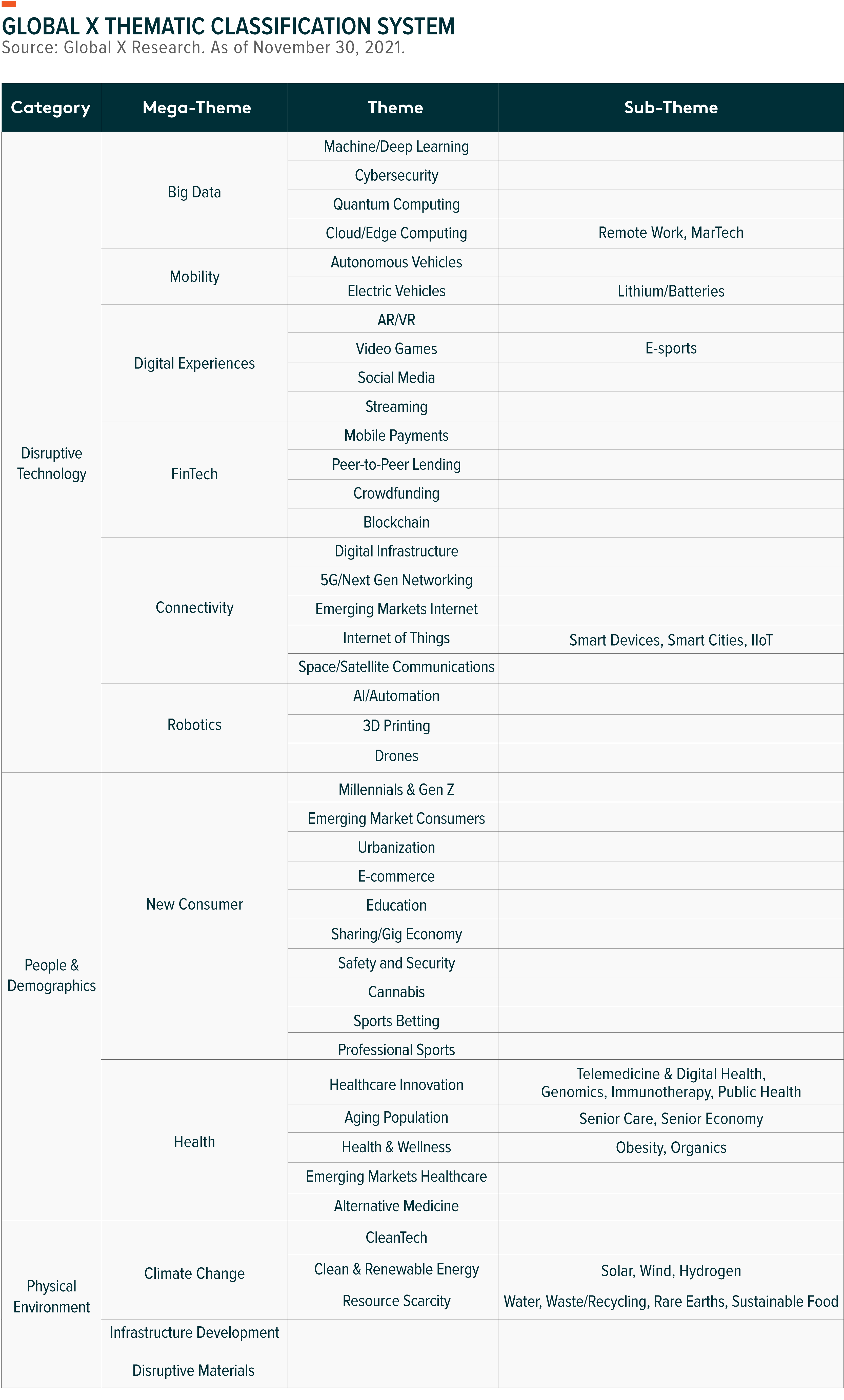European Thematic UCITS ETFs Report – November 2021
The Global X research team is pleased to release the European Thematic UCITS Report for November 2021. The report recaps Global X’s classification system for disruptive themes and the thematic ETFs that track them. It also provides industry-level analysis of thematic investing ETFs, looking at new launches and closures, assets under management (AUM) movements, and fund flows.
Click here to download the European Thematic UCITS ETFs Monthly Report for November 2021
European Thematic UCITS ETF Landscape – November 2021 Recap
At the end of November 2021, there were 81 thematic UCITS ETFs totalling US$41bn in assets under management (AUM), falling 2% on the month. Themes in disruptive technologies recorded largely flat AUMs in November as compared to October, while themes in the people & demographics category recorded the largest decrease (9%) followed by the physical environment category, which fell by 2%.
In November, UCITS Thematic ETFs recorded US$823m of net inflows, after attracting US$710m in October
- Climate change themes continued to attract the largest net inflows this month (US$387m) following the UN COP26 climate conference, with the bulk of net new inflows going into clean & renewable energy themes (US$219m) and resource scarcity themes (US$164m)
- Cybersecurity theme saw significant net inflows of US$157m this month, following the publication of a survey from the European Commission showing that more half of Europeans worry about cybercrimes
- Electric Vehicles (EV) theme also benefiting from an increased investors’ interest for sustainably-themes garnering US$126m of net inflows this month. Besides, EV sales were at record highs in October and almost doubling on a year-over-year basis both in Europe and in the US
- Emerging market connectivity theme continued to attract strong net inflows for the fourth consecutive month (US$141m)
- E-commerce theme saw another month of net outflows (US$84m) possibly reflecting an improved consumer confidence in October as concerns about the spread of the Delta variant eased. However, rising Omicron fears and the returns of social distancing measures might lead to a rebound in flows in the coming months
Global X’s Thematic Classification System
Global X’s research team established a thematic classification system that provides a consistent framework for identifying disruptive themes and categorising the thematic ETF space. Often, we have seen conflicting definitions of thematic investing in the media and financial world, which leads to confusion about which ETFs are thematic and what themes they are tracking. With the introduction of this classification system, we hope to provide more clarity around disruptive themes and their related ETFs.
Defining Thematic Investing
Global X defines thematic investing as the process of identifying powerful disruptive macro-level trends and the underlying investments that stand to benefit from the materialisation of those trends.
By nature, thematic investing is a long term, growth-oriented strategy, that is typically unconstrained geographically or by traditional sector/industry classifications, has low correlation to other growth strategies, and invests in relatable concepts.
Notably, thematic investing does not consist of ESG, values-based, or policy-driven strategies, unless they otherwise represent a disruptive structural trend (e.g. climate change). Further, funds that adhere to traditional sector or industry classifications, or that are used primarily to gain exposure to cyclical trends (e.g. currencies, valuations, inflation) are not considered thematic. Finally, alternative asset classes, such as listed infrastructure, MLPs, and ubiquitous commodities are not considered thematic.
Classifying Themes
Global X’s thematic classification system consists of four layers of classifications: 1) Categories; 2) Mega-Themes; 3) Themes; and 4) Sub-Themes, with each layer becoming sequentially narrower in its focus.
‘Categories’ is the broadest layer and represents three fundamental drivers of disruption: exponential advancements in technology (Disruptive Technology), changing consumer habits and demographics (People & Demographics), and the evolving physical landscape (Physical Environment).
One layer down are ‘Mega-Themes,’ which serve as a foundation to multiple transformative forces that are causing substantial changes in a common area. Conceptually, Mega-Themes are a collection of more narrowly targeted Themes. For example, Big Data is a Mega-Theme that consists of Machine/Deep Learning, Cybersecurity, Quantum Computing, and Cloud/Edge Computing.
Further down, we identify ‘Themes’ as the specific areas of transformational disruption that are driving technology forward, changing consumer demands, or impacting the environment. There are currently 40 themes in the classification system.
‘Sub-Themes’ are more niche areas, such as specific applications of themes or upstream forces that are driving themes forward.

Thematic ETFs can target a specific category, mega-theme, theme, or sub-theme. Our categorisation process seeks to find the best fit for a specific ETF, analysing its methodology, holdings, and stated objectives. The thematic classification system is reviewed quarterly to consider new potential categories, mega-themes, themes, or sub-themes. As a new ETF launches or changes its strategy, its classification is evaluated immediately.
Conclusion
In an uncharted era of new technologies disrupting existing paradigms, demographics reshaping the needs of the world’s population, shifting consumer behaviors forcing changes to existing business models, and dramatic changes in our physical environment, we find that there is a growing need for a consistent framework to track these themes and the investment vehicles providing access to them.
This document is not intended to be, or does not constitute, investment research